Recently, Anthony Brookes, a Professor of Genomics and Health Data Science at the University of Leicester, wrote a piece for the Daily Sceptic arguing that central to the virus’s surge-and-decline behaviour is the emergence of new variants, which are “able to infect (or re-infect) some fraction of individuals”.
He writes:
A series of SARS-CoV-2 variants have arisen, many of which possessed a transient selective advantage that led to a wave of infection that peaked some three-to-four months later. Several such variants have spread globally, though different successful variants have arisen simultaneously in a number of countries. The result is a three-to-four month wave pattern per country, which is also apparent globally.
The global wave pattern is shown below. It features an extended autumn and winter wave, a spring wave and a summer wave (seasons here for the northern hemisphere, of course). Note that this graph is raw positive test numbers so does not allow for increased testing.
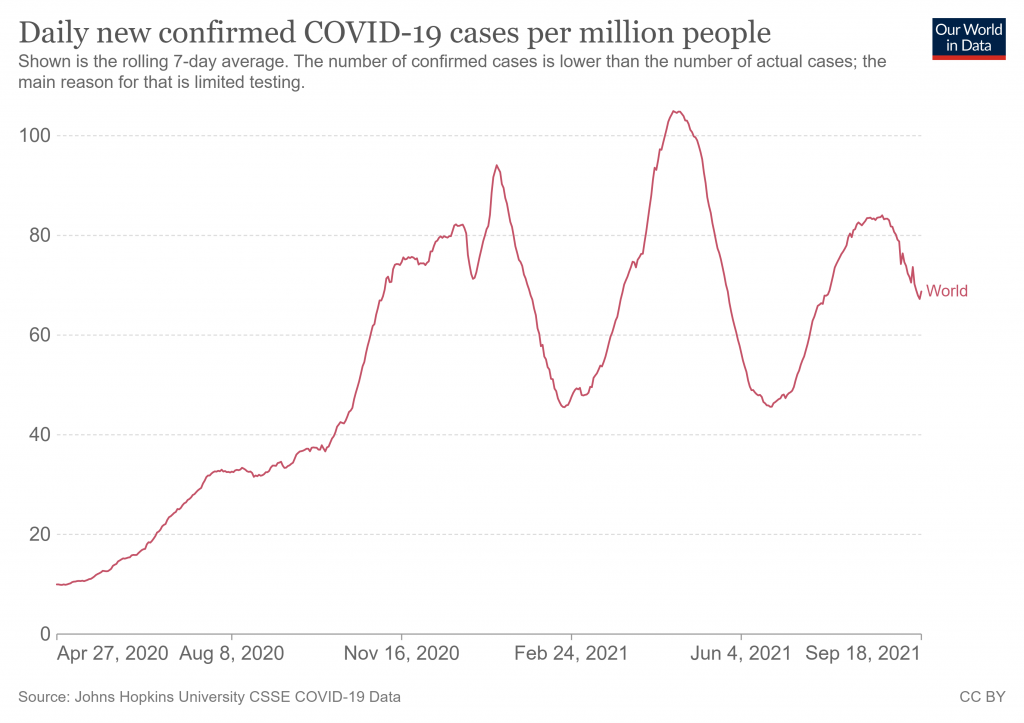
To illustrate how this global pattern is reflected in different countries and how it relates to the emergence of new variants, I have superimposed the graph of variant proportions over time from the CoVariants website onto the positivity rate curves (the proportion of tests that come back positive, which takes into account changes in the amount of testing) from Our World in Data. I’ve done this for the 12 countries which have done the most sequencing of virus samples (according to CoVariants), plus Israel and South Africa.
Note that the sequencing data is not necessarily representative, though the more sequencing that is done the more likely it is to be representative. Jagged lines in early data indicate small samples that are unlikely to be representative. Grey areas are unidentified variants.
My apologies that it is difficult to read the dates along the bottom of these composite images but hopefully you can see enough to figure out what is what.
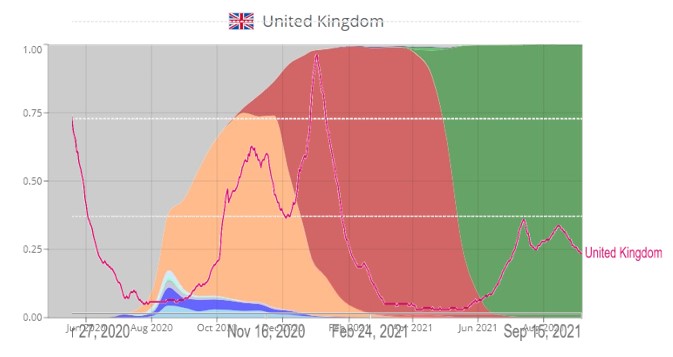
The three peaks in the U.K. are associated with the three dominant variants: the ‘Spanish’ variant (20A.EU1) in orange in autumn 2020, Alpha in red in the winter and Delta in green in the summer. The Alpha surge was large, presumably due to it occurring in the winter. Note the lack of a spring 2021 surge, which in other countries was associated with Alpha.
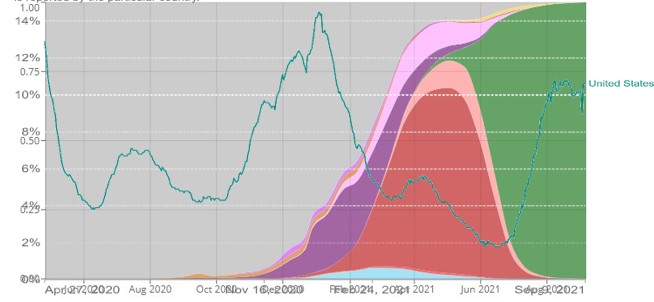
There is evidence in the U.S. of a small spring surge associated with Alpha and a larger summer one associated with Delta. There is no data here on the variant(s) associated with the large winter wave or the smaller summer 2020 surge.
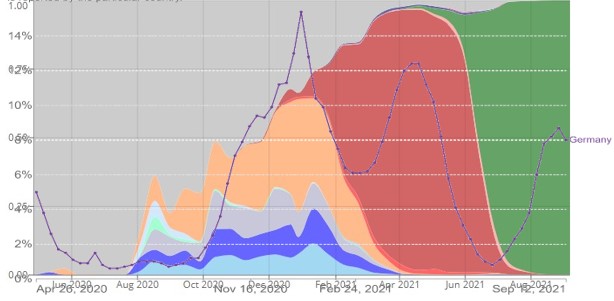
The Spanish variant is significant in the large winter surge in Germany, but is not dominant on this data. The spring surge associated with Alpha and the summer surge associated with Delta are present again.
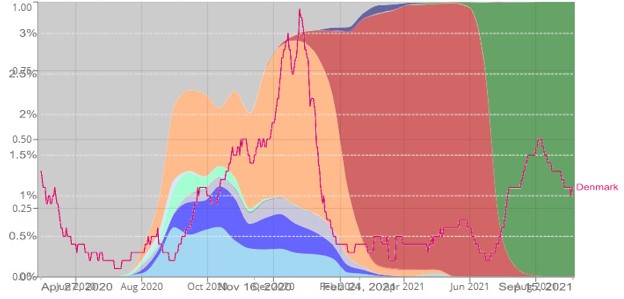
The large winter wave in Denmark is associated with the Spanish variant, though again it is not entirely dominant on this data. The spring bump associated with Alpha is there but very small, while the summer surge associated with Delta is more pronounced.
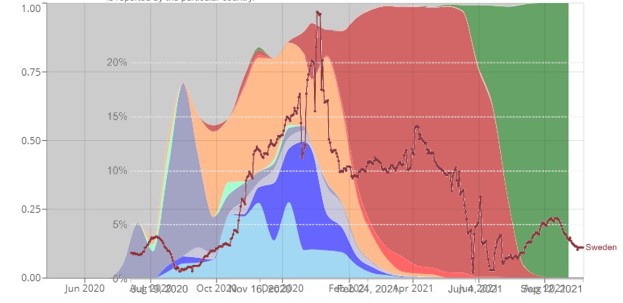
Sweden’s large winter wave was mixed variant-wise, though data at this point was sparse (indicated by the jagged lines). Alpha is associated with a slowing of the drop-off from winter and a second peak. Delta so far in the summer is associated with only a small ripple.
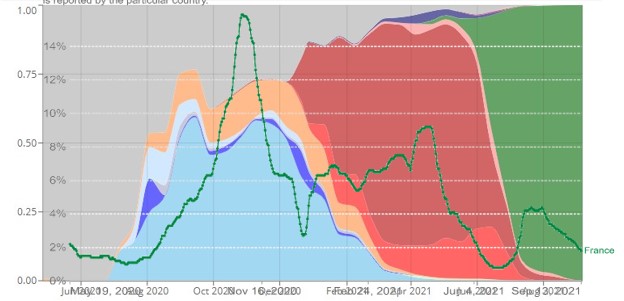
France’s large autumn surge was mainly associated with the ‘French’ variant (20A.EU2) in light blue, though again it was not entirely dominant. The subsequent winter peak was very muted, though a spring surge associated with Alpha and a smaller summer ripple associated with Delta are present.

Variant data was sparse before spring 2021 in Japan, but the two most recent surges are associated with Alpha in the spring and Delta in the summer.

The Netherlands’ positivity curve is bumpier than most, but there appears to be a large winter wave associated with (though not dominated by) the Spanish variant, a spring resurgence associated with Alpha and a summer surge associated with Delta.
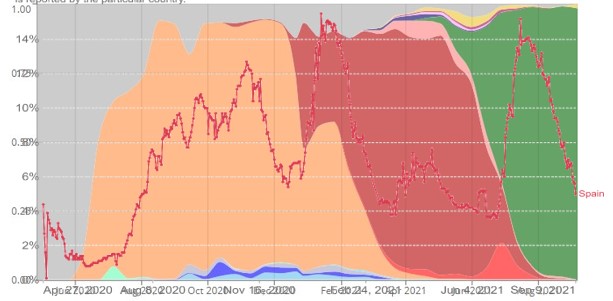
Spain’s autumn surge is dominated by the Spanish variant, but its winter wave seems to be a mixture of Alpha and the Spanish variant, while there is also a spring bump associated with Alpha. A summer surge associated with Delta is clear. Spain is unusual in having four peaks but three dominant variants, perhaps a result of the winter wave occurring just as Alpha was taking over from the Spanish variant.

Canada had little data till recently. While a summer surge associated with Delta is clear, the spring surge is associated with both Alpha and other variants, including Gamma (in pink).
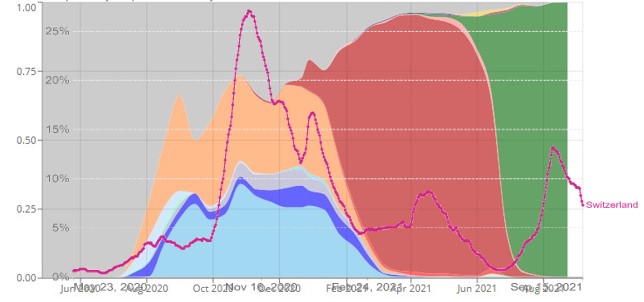
Switzerland’s autumn and winter wave featured a mix of variants, especially the French and Spanish. Alpha is associated with a spring bump and Delta with a moderate summer surge.

A large and extended autumn and winter wave associated with the Spanish variant is evident in Italy, and is similar to Spain in that Alpha takes over from the Spanish variant during the winter. There is then also a spring bump associated with Alpha and a small summer ripple associated with Delta.
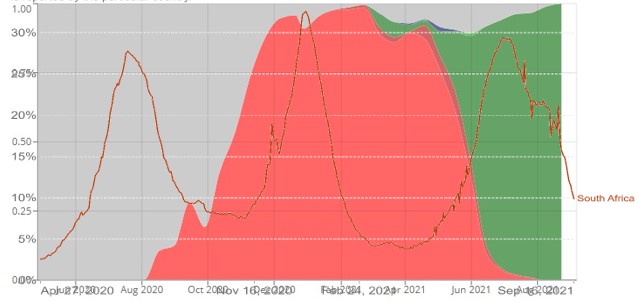
South Africa has not sequenced so many samples as the countries above, but a summer wave associated with Beta (light red) is evident, as is a winter wave (in this case) associated with Delta. South Africa is the only one of these countries where Alpha never became dominant, apparently being squeezed out by Delta.
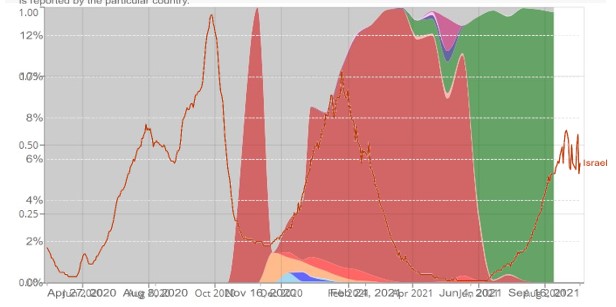
Sequencing in Israel has also been quite sparse, but there is some evidence of a winter wave associated with Alpha and a summer surge associated with Delta. The lack of spring bump may be, as in the U.K., because the Alpha wave occurred over winter.
These 14 graphs illustrate how variants are associated with surges in different countries. Importantly, almost every time there is a surge and a peak it is associated with one of the highly successful variants (Delta, Alpha, Spanish, French). The main exception is in winter, when there is a peak anyway, though even then it is usually associated with these variants in some way.
Importantly, by way of control, the U.K. and Israel show that when Alpha was the dominant winter variant, the spring peak, typically associated with Alpha, was absent.
This is to my mind compelling evidence that variants play a key role in driving new surges of coronavirus. It suggests that herd immunity is to some extent variant-specific, and that a new variant temporarily disturbs the herd immunity until the latest wave of infections tops it up again.
There is no sign yet of the emergence of a new successful variant that will take over from Delta. This holds out the hope that Delta may be some kind of evolutionary endpoint or optimum for the virus, and thus that the autumn and winter may be mild from a Covid point of view – though other viruses like flu may take the opportunity to make a comeback.











To join in with the discussion please make a donation to The Daily Sceptic.
Profanity and abuse will be removed and may lead to a permanent ban.
The media are talking about Lucy Letby as if it is a fact that she is guilty. She is innocent until proven guilty. She was judged to be guilty by a jury, but she was not proven guilty. No proof was presented, no direct evidence, just weak circumstantial evidence, questionable statistics, authoritative doctors asserting that she is guilty, and a stream of consciousness rambling note, including saying “I did nothing wrong”. There is nothing in her character to suggest that she is unkind, never mind an evil serial killer of babies.
From yesterday’s Telegraph:
‘A campaign to fundraise for Lucy Letby’s appeal has claimed the nurse’s conviction “may represent the greatest miscarriage of justice the UK has ever witnessed”.’
https://www.telegraph.co.uk/news/2023/08/23/lucy-letby-campaigners-freedom-launch-fundraising-appeal/#:~:text=A%20campaign%20to%20fundraise%20for,the%20UK%20has%20ever%20witnessed”.
Dr Richard Gill:
“I’m not saying that I know that Lucy Letby is innocent. As a scientist, I am saying that this case is a major miscarriage of justice. Lucy did not have a fair trial. The similarities with the famous case of Lucia de Berk in the Netherlands are deeply disturbing.”
https://gill1109.com/2023/05/24/the-lucy-letby-case/
Science On Trial website:
“Based upon published peer-reviewed research, and with the guidance, advice, and insights of other scientists, it is the view of Science on Trial that the scientific information put before the court by the expert witnesses is very simply inaccurate, misleading, and in many places false. The expert witnesses in this case are likely aware that the claims they have made lack necessary scientific findings, and if they were to write these claims up and attempt to submit them for publication, their submission would be quickly rejected.”
https://rexvlucyletby2023.com
“Do Statistics Prove Accused Nurse Lucy Letby Innocent?
Statistical analyses, a damning 2016 report by the Royal College of Paediatrics and Child Health (RCPCH), and various other factual inconsistencies in publicly available official documents, may constitute reasonable doubt”
https://www.chimpinvestor.com/post/do-statistics-prove-accused-nurse-lucy-letby-innocent
Some of us remember what the media said at the time about the Birmingham Six and the Guildford Four, and what the judges said.
Well said. It is a disturbing case for sure. How the CPS proceeded on the case as presented is baffling. Are we still prosecuting to ‘beyond reasonable doubt’..?
In much of the West, what matters now is what people “feel” to be true, not what is evidently true. When this folly infects the criminal justice system then we have a serious problem indeed.
The CPS is a seriously disturbing outfit made up of complete also-rans.
Isn’t that right Kneel?
The press response (ongoing since conviction) seems to confirm that societies under stress need scapegoats to vent their general frustration.
I recommend this video where Norman Fenton talks to Scott McLachlan about the qualitty of the evidence used in the case https://www.bitchute.com/video/k12f_VFCbtI/
I suppose I shouldn’t be surprised about how few commentators have asked questions about this trial, content that someone has been convicted for infant deaths. Whether she is innocent or not once again the NHS is shown to be hopelessly incompetent, callous and self-serving. My gut feeling is that she’s been used as a scapegoat and I hope that she has family and friends who can campaign for a proper investigation and appeal.
Mogs – PM.

Blimey – 11:10 am and seven downticks and I haven’t even tried to be controversial.
We are being swamped with snowflakes.
The first “Putin is a cold blooded murderer” article isn’t exactly the hottest, most sceptical take is it.
“All the (slightly mad) ways you can beat Sadiq Khan’s Ulez charge” – Those looking to dodge the London Mayor’s £12.50 Ulez fees can get compliant or get creative, says the Telegraph.
I slightly misread the penultimate sentence:
You can try TfL’s ‘check your vehicle, tool‘ to find out whether you’ll face the daily charge.
I would have thught that the easiest way to collapse Ulez is for absolutely everybody to refuse to pay their fines, as the system would just implode.
Ah but these cameras are not just there for ULEZ, in future they will do road pricing, traffic control and of course most new cars will be under satellite and mobile digital control by which time any miscreants will find their cars will be simply locked off.
Time to spread the word about 5G
5G towers digital watchtowers
Black & White Freedom Leaflets to print at home any size
If you print A4 they could be used as inserts for Light Papers for example
ULEZ,… the wrath of Khan!
“Emily Bridges doesn’t belong on Vogue’s female power list”
The greatest asset of being a successful woman is ,to be a man!
One recalls the oaf Brown’s “Big conversations”; one of which – on drug legislation was taking place (apparently) when Brown himself decided off the cuff to up the classification of Cannabis from C to B.
The only conversation politicians believe is when they shower you with s**t.
Good morning everyone..two stories from Germany, that just confirm we live in clown world…and that we are at war with these globalist overlords…
https://www.thelocal.de/20230823/judge-gets-suspended-sentence-over-covid-mask-mandate-rebellion
A family judge who attempted to overturn a Covid mask mandate at two schools in Weimar has been given a two-year suspended sentence.The prosecution had requested a three-year jail term for the judge, who was found guilty of judicial misconduct on Wednesday by the Erfurt Regional Court. The defence had sought an acquittal.
In April 2021, the family judge ruled that children at two schools in Weimar did not have to wear Covid masks in class, contrary to the rules set at the time by the Thuringian Ministry of Education. His decision was later overturned by higher courts. which said he had never been authorized to make rulings of this kind.
https://www.racket.news/p/madness-american-satirist-cj-hopkins?utm_campaign=post&utm_medium=web
from Matt Taibbi and well worth a read….
“Just when you may have thought things couldn’t get any crazier: American playwright and humorist C.J. Hopkins has been sent a “punishment order” by a German judge, offering him a Sophie’s Choice of 60 days in jail or 3,600 euros.
His crime? Essentially, insulting the German health minister in a tweet, and using a scarcely-visible image of a Swastika on a mask in a book critical of the global pandemic response, The Rise of the New Normal Reich. He was first accused of this “crime” in June, shortly after Roger Waters was placed under investigation for wearing his clearly satirical “Pink” costume in a stage performance in Berlin. As I wrote when C.J. was charged weeks later, authorities claim that through the use of the mask image, C.J. was “disseminating propaganda, the contents of which are intended to further the aims of a former National Socialist organization.”
https://www.thelocal.de/20230823/judge-gets-suspended-sentence-over-covid-mask-mandate-rebellion
I posted this last night Mrs Gums.
Proud to be B-Corp
Our business meets the highest standards of verified social and environmental performance, public transparency and legal accountability to balance profit and purpose. In short, we care about people and the planet.
This is the blurb I have just found on the World of Books website, one of my go-to’s for second hand books. Now off my go-to list. Very disappointing.